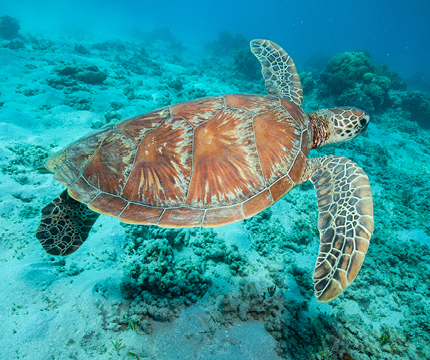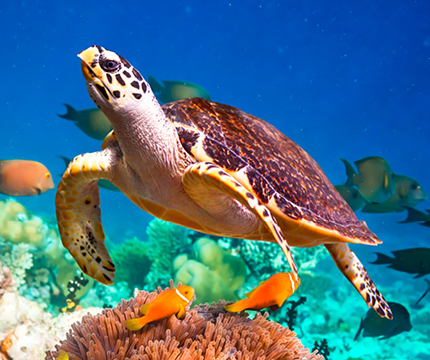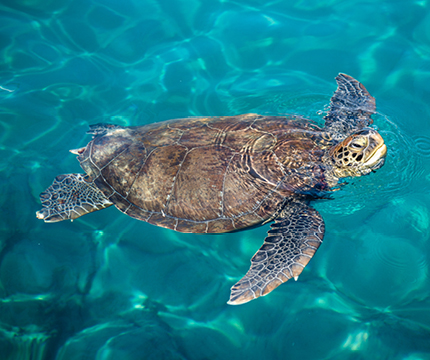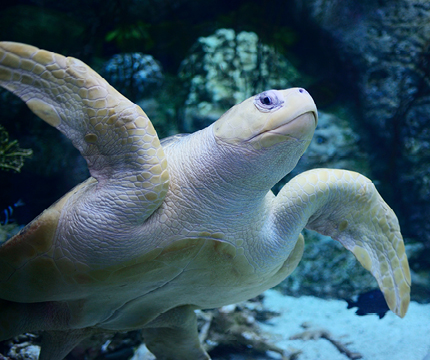Marine Turtles
This turtley awesome reptile has been around for over 130 million years! They use their lungs to breathe, just like we do. Some species can hold their breath for up to seven hours, slowing their heartrate to a single beat every nine minutes to conserve energy.
They come in a range of colours, including olive-green, grey, yellow, greenish-brown, reddish-brown or black. Marine turtles can range in size from 70cm to 125cm in length and are characterised by a long, streamlined shell. The shell on their back is called a ‘carapace’, while the shell on their underside is called a ‘plastron’. Diets vary greatly among marine turtles and can include seagrass, algae, sponges, sea jellies, crustaceans, gastropods, sea cucumbers and soft corals. They have special glands in their eyes which excrete the salt they ingest when feeding.
Of the seven species of marine turtle, six are found within Australian waters. Four of these can be seen within the waters of the Fraser Coast, including:

Green turtle (Chelonia mydas)
Green turtles are smooth olive-green (variegated with brown, reddish-brown and black) high-domed carapace between 88-125cm in length. It weighs between 113-204kg. Hatchlings are shiny black above and white below with white margins around the carapace and flippers.
While immature Green turtles are carnivorous, adults feed mostly on seagrasses and algae.
Conservation status: Vulnerable

Hawksbill turtle (Eretmoschelys imbricata)
The Hawksbill turtle is olive-green or brown above and richly variegated with reddish-brown, dark brown and black. The scales of the head and face are often dark with pale contrasting sutures (lines between the scales) and it is cream to yellowish below.
They can measure up to 82cm in length and weigh around 50kg. Hawksbill turtles are omnivorous (eat both plants and animals), surviving on sponges, seagrasses, algae, soft corals and shellfish.
Conservation status: Vulnerable

Loggerhead turtle (Caretta caretta)
The Loggerhead turtle has a dark brown heart-shaped carapace between 80-110cm in length. The tope of their head of dark brown, becoming pale on the sides with irregular darker blotches and white, cream or yellowish below. Loggerhead hatchlings are a rich reddish-brown above and dark blackish brown below.
The weight of Loggerhead turtles varies between 70-170kg. A carnivorous species, the diet of Loggerhead turtles consists of shellfish, crabs, sea urchins and sea jellies.
Conservation status: Endangered

Olive Ridley turtle
Olive Ridley turtles are grey or olive-grey above, usually without any conspicuous markings, and whitish below. Their carapace is broad and heart-shaped, with six or more costal scales (the scales that sit either side of the vertebral scales which run down the middle of the turtle’s ‘back’).
They can grow to a total length of 1.5 metres and weigh up to 40kg. Hatchlings are blackish above and dark brown below. They are a carnivorous species, feeding of shellfish and small fish.
Conservation status: Endangered
Conservation
Marine turtle conservation and management in Queensland commenced in 1932, making it the longest in Australia’s history. In 1968, Queensland became the first jurisdiction in the world to protect all marine turtle species within its borders. All marine turtle species are protected in Australian waters and are classified as either ‘vulnerable’ or ‘endangered’ under the Environmental Protection and Biodiversity Conservation Act (1999) (EPBC).
Maintaining healthy turtle populations is important for the biodiversity of our oceans, as well as for cultural and social values. Turtles also contribute significantly to the local economy through tourism.
Marine turtles perform an important ecological function in the shaping and regulation of coastal marine communities by contributing to the maintenance of healthy seagrass beds and coral reefs, helping to balance marine food webs and facilitate nutrient cycling.
You can help marine turtles by:
- Properly discarding fishing equipment and retrieving any you find
- Reducing your boat speed in shallow seagrass and coral reef areas
- Reducing your use of plastic and dispose of it properly
- Preventing your pets from disturbing nesting females, nests and hatchlings
